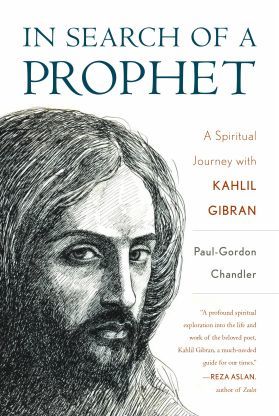Paul-Gordon Chandler holds a unique position within the domain of activists seeking to deploy art to address cultural misunderstanding and conflict. After years of serving as an Episcopal priest in Cairo, Egypt, he founded CARAVAN, a non-profit organization that promotes visual art as a vehicle to build bridges between the Middle East and the United States and Europe, supporting individual Middle Eastern artists and coordinating exhibitions. This work led him to Arab-American writer Kahlil Gibran as a foremost proponent of bridge-building, with continued appeal internationally that crosses all generational and cultural difference. To understand Gibran’s efforts toward unity and his spiritual evolution, Chandler resolved to follow Gibran’s historical path through the places he lived and to contemplate his life and mind. Now he has released a book recording these experiences, entitled In Search of a Prophet: A Spiritual Journey with Kahlil Gibran and published by Rowman and Littlefield in September 2017. Here I present an interview with him about his work and the book.

1. The CARAVAN project advances the power of art in bridging cultural difference and demonstrating universal humanity. What did you identify in the work and personality of Kahlil Gibran that connects with this mission?
CARAVAN, a peacebuilding arts non-profit that originated out of Cairo, Egypt, believes that the arts can be one of the most effective mediums to build bridges between the creeds and cultures of the Middle East and the West. In my travels in connection with this work, I was repeatedly struck by how enthusiastically the poet-artist Kahlil Gibran was loved both throughout the Middle East and in much of the West. I began to see him as a supreme East-West uniting figure, and this intrigued me to look more deeply, not just into his life and work, but also into his inner spiritual journey. More specifically, I sought to understand what led him from being someone born into what was then an exclusive, sectarian and intolerant historic Christian community in Lebanon, to becoming someone who embraced all in our world, and as a result became one often embraced by all.
During a time of escalating misunderstanding, stereotypes and even violence between religions and cultures in our world today, I believe Kahlil, through his life, work and approach, can be an unparalleled guide for our times, related to peace, harmony, and the building of bridges between cultures and creeds. He was a natural mystic who quite simply sought to build bridges and tear down walls.
It was evident that his life was lived toward a deeper dimension, and he wove this passionate intent into the core of his writings and art. The depth of Kahlil’s spiritual journey led to an extraordinary breadth of spirit in which he experienced the oneness of humanity. The reservoirs he had cultivated in “the deep” gave him the capacity to go “wide.” Arising from his internalized bridging of the Eastern and Western influences of his life, a faith emerged over time that transcended all cultures and religions. He went beyond religion to the core of a universal spirituality. In his art, especially his writing, he sought to find ways to powerfully communicate a nonsectarian version of spirituality.
Kahlil once asked, “We have forgotten—or have we?—that there is but one universal language and that its voice is art.” Later he went on to say, “Your neighbor is your other self dwelling behind a wall. In understanding, all walls shall fall down.” The arts can help us put ourselves in the Other’s shoes.
2. Your new book links Gibran’s creative and spiritual development with his experience of place -- particularly in Lebanon, Boston, Paris, and New York. What did you find in these places that helped you understand Gibran and his unique personality? What do think we could describe as “American” or America-inspired in the thinking and expressions of Kahlil Gibran.
I began my journey in Kahlil’s birthplace village of Bscharre high up in the snowy mountains of Lebanon, among the cedar forests, which breathed life into much of the imagery found in his writings – mountains, rivers, villagers, sages, and a wealth of natural beauty. Although he spent only twelve short years in this magical mountainous setting, it was to serve as the foundation of his spirituality and worldview for the rest of his life.
In contrast to the gorgeous peaceful surroundings, he was born into a Maronite Christian family during a period of political and interreligious strife, as well as one full of corruption by religious authorities, during the latter part of a 400-year long Ottoman occupation.
When Kahlil was 12 years old he and his family emigrated to Boston and settled into the South End. Kahlil began to learn English and a whole new world of artistic influences began to inspire him. As a young teenager, he met the avant-garde Bostonian photographer and publisher Fred Holland Day, who was equally intrigued with Kahlil, and Day introduced him to a vast new world of literature and art and encouraged his artistic ability.
Having matured into young adulthood and as an immigrant in America, Kahlil discovered that he had the liberty to write in a way that he would not have been able to while living in the Arab world at the time. This “America-inspired” opportunity allowed him to tap into the confluence of East and West and to explore the oneness of humanity, becoming a natural bridge between creeds and cultures.
With boldness and without censorship he crafted stories and articles addressing highly sensitive issues. He began to call on his people to question ideologies as he himself began to grapple with religion and spirituality. He spoke out in his articles against Ottoman oppression, sectarian strife often fueled by religious authorities, and the violation of women’s rights.
Through the generous help of his lifelong friend and patron Mary Haskell, Kahlil was given the opportunity to study art in Paris for several years, enabling him to master the fundamentals and discover his own unique style. Paris was a city bursting with creative energy as some of the great Impressionist artists were still around: Monet, Renoir, Degas, and Mary Cassatt. Upon Kahlil’s return to Boston, he began to feel the need for a larger artistic venue in which to develop his talents and New York City became the place in which he spent most of his career. It was a place in which he could retire to his “hermitage” studio apartment in Greenwich Village as well as benefit from the inspiring stimulation of a dynamic cultural setting.
3. Kahlil Gibran demonstrates a great interest in Jesus Christ, yet Gibran’s interpretation of Jesus might be seen as unconventional or subtly distinct. How did you come to understand Gibran’s view of Christ? Do you think this view changed over his lifetime?
Interestingly, as Kahlil continued to journey spiritually he sought to sift through his own religious upbringing, through all the baggage, trappings and traditions that have accumulated over the millennia. He came to see the person of Jesus far beyond Christianity as a Universal Sage for all humanity.
In Jesus, Kahlil saw an all-embracing figure, and he was enraptured by his character. He wrote, “His life is the symbol of Humanity. He shall always be the supreme figure of all ages.” One of my favorite little vignettes of Kahlil’s is about his resolve to separate the Jesus of history from the Jesus of Christianity.
Kahlil wrote: “Once every hundred years Jesus of Nazareth meets Jesus of the Christian in a garden among the hills of Lebanon. And they talk long; and each time Jesus of Nazareth goes away saying to Jesus of the Christian. ‘My friend, I fear we shall never, never agree.’”
Observing the corruption and inequalities and sectarian power plays of the Church in Lebanon as a young man, he was naturally drawn to the radical aspect of Jesus’s all-embracing inclusive love and the strength of his humility, the antithesis of the Church he had experienced.
The further Kahlil delved into the personality of Jesus, the more he felt he had met a compatriot, who had walked along paths of life he had traversed – suffering, joy, hypocrisy, injustice, fear, courage and a sense of destiny. In his sleep, Kahlil often dreamed of Jesus coming to him, walking with him, sitting with him, and talking to him.
He also pictured Jesus as a fellow Middle Easterner and felt a deep personal cultural connection to him. Hence, the opportunity to write about Jesus’s life became an ever-increasing aspiration. By the time Kahlil began to write his book on Jesus, he had moved beyond both the religious disillusionment of his youth and the need to antagonize religious authorities to make his point. No longer critical, he chose to soar above the fray. Jesus the Son of Man was the longest and last book Kahlil wrote before his death, and some see it as a sort of “fifth gospel.” In it he delivers a mesmerizing picture of the essence of Jesus.
